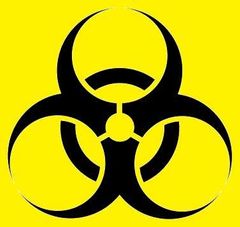![]()
![]()
![]()
Use LEFT and RIGHT arrow keys to navigate between flashcards;
Use UP and DOWN arrow keys to flip the card;
H to show hint;
A reads text to speech;
36 Cards in this Set
- Front
- Back
|
Containment priniciples, technologies, and practices that are implemented to prevent unintentional exposure to pathogens and toxins or their accidental release. |
BIOSAFETY |
|
|
Protection, control and accountability for valuable biological materials within laboratories, in order to prevent their unauthorized access, loss, theft, misuse, diversion, or international release. |
BIOSECURITY |
|

|
BIOHAZARD |
|
|
Who created it? |
Charles Baldwin |
|
|
Procedures and practices to prevent exposure and acquisition of infections. |
BIOSAFETY |
|
|
Maintenance of secure procedures and practices in handling biological materials and sensitive information |
BIOSECURITY |
|
|
Risk group classification of microorganisms is based on the: |
•Pathogenicity •Mode of transmission •Host range •Availability of preventive measures •Effective treatment |
|
|
-Unlikely to cause human or animal disease |
Risk Group 1 |
|
|
Low individual or community risk |
Risk Group 1 |
|
|
Unlikely to be a significant risk to lab workers, community, livestock, or environment |
Risk Group 2 |
|
|
With available preventive measures and effective treatment |
Risk Group 2 |
|
|
Moderate individual risk and limited community risk |
Risk Group 2 |
|
|
Known to cause serious diseases to humans or animals significant risks to lab workers |
Risk 3 |
|
|
With available preventive measures and treatment |
Risk Group 3 |
|
|
With high individual risk, limited to moderate community and environmental risk |
Risk Group 3 |
|
|
Known to produce life-threatening disease to humans and animals |
Risk Group 4 |
|
|
Significant risk to laboratory workers |
Risk Group 4 |
|
|
Readily transmissible from one individual to another |
Risk Group 4 |
|
|
High individual and community risk |
Risk Group 4 |
|
|
Preventive measures and treatment are not usually available |
Risk Group 4 |
|
|
Categories of Laboratories Biosafety According to Levels |
Biosafety Level 1 Biosafety Level 2 Biosafety Level 3 Biosafety Level 4 |
|
|
Biosafety level designations are based on: |
•Composite of the design features, •Construction, •Containment facilities, •Equipment, •Practices, and •Operational Procedures
|
|
|
Suitable for working with viable microorganisms known not to cause disease in humans |
Biosafety level 1 |
|
|
Most appropriate for undergraduate and secondary educational training and teaching laboratories that require basic practices. |
Biosafety Level 1 |
|
|
Examples of species in BSL-1 |
•Bacillus subtilis •Naegleria gruberi |
|
|
Applicable to clinical, diagnostic, and teaching labs |
Biosafety Level 2 |
|
|
Appropriate in working with human blood, body fluids, tissue, cell lines, etc. |
Biosafety Level 2 |
|
|
Give exaples of virus/species used in Biosafety Level 2. |
• Hepatitis B virus •HIV •Salmonellae •Taxoplasma species |
|
|
Emphasis on primary and secondary barriers in the protection of personnel, community and environment from infectious aerosol exposure |
Biosafety level 3 |
|
|
Work with indigenous or exotic agents with potential for respiratory transmission, serious and lethal. |
Biosafety Level 3 |
|
|
Secondary barries for this level is highly required including controlled access to the laboratory and ventilation requirements |
Biosafety Level 3 |
|
|
Ventilation with special engineering and design features are being considered to minimize the release of infectious aerosol from the lab |
Biosafety Level 3 |
|
|
For working with dangerous and exotic agents that pose individual risks of life threatening disease without available vaccines or treatment |
Biosafety Level 4 |
|
|
Examples of microbes in BSL-3 |
•Mycobacterium tuberculosis •St. Louis encephalitis virus •Coxiella |
|
|
Give examples of microorganisms in BSL 4 |
Marburg or Crimean-Congo hemorrhagic fever |
|
|
For laboratories with indigenous moderate-risk agents |
Biosafety Level 2 |

